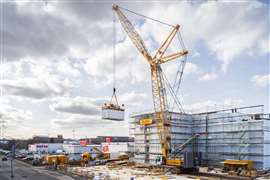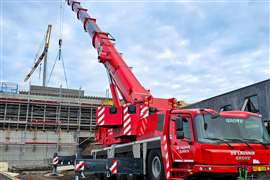Dropping the ball
15 April 2008

Foundation preparation after a building or site demolition has become prime work for demolition and foundation contractors. The process of dynamic compaction has allowed these contractors to become experts at transforming substandard land into prime real estate. Such is the case for Hayward Baker, a contractor that does all kinds of foundation work, including deep dynamic compaction.
Dynamic compaction involves the process of densifying soil to significant depths to make the site more stable for building. The densification happens as a result of a systematic lifting and dropping of a heavy weight on a pre-determined grid. The process of deep dynamic compaction requires the work of a crawler crane, typically one with duty-cycle attributes, one that can handle the grinding task of repetitive lifts and drops at a weight that can exceed 30 tons.
“We do dynamic compaction after demolition work, and we do dynamic compaction on land that is considered hazardous or unfit for building,” says DuWayne Peterson, project superintended for deep dynamic compaction projects for Hayward Baker. “Dynamic compaction is good for about 40 feet deep. It offers another option rather than the costly process to remove the soil and debris and add in fill.”
In New Jersey, a shopping center sits on land once occupied by a plastics factory. The factory was demolished, with the steel hauled off but the crushed concrete and other debris left behind.
“In the business of making plastics, solvents are used that get into the soil that are dificult to handle,” says Peterson. “At this site in New Jersey, they didn't want to remove anything because of the solvents used. We did deep dynamic compaction over the entire site. Then the owner hauled in fill material and built the shopping center.”
On that job, Peterson says his crews utilized a Manitowoc Model 4000. However, today the company exclusively uses Manitowoc Model 1015s for dynamic compaction work.
The company recently completed a project in Tempe, AZ that is in view of the Arizona State Sun Devil stadium. The land was previously used as a landfill for gravel and other substances, including concrete and even domestic garbage.
The land was ranked as hazardous, with the lowest designation of development viability given by the city.
“We were brought in because the city wanted to change it from the lowest land the city can have to one of the highest,” he says. “We did deep dynamic compaction over the whole site, dropping a 30 ton weight from 85 feet 77,000 times.”
Peterson says it took the better part of a year to complete the process. He says, “It was pretty steady running.” Using a Manitowoc Model 1015, Peterson says thework was made easier, because the crane has an on-board computer that can be programmed to do the repetitive lift, drop, lift, drop work.
“The computerized process makes it much more consistent and much safer operation,” says Peterson, who specializes in jobs in which the Model 1015 is used. “Dynamic compaction is a violent process. If the ground is moving, you are going to move with it. This work is very hard on a crane, very stressful. Our Model 1015 is a 120 ton rated lift crane but we only pick 30 tons. This work is hard on the crane but it performs admirably.”
John Wessel, regional business manager for Manitowoc Crane Group, says, “Hayward Baker is the leading US company performing DDC work, and is a long-time Manitowoc crane customer.”
Manufactured for adapting to duty-cycle applications, the Model 1015 has 33 tons of continuous line pull at all rope layers on the drum. The crane also has a unique performance feature in that each winch has two hydraulic motors powering it and the option to divert the pump flow to one winch at a time for faster line speeds. This design provides a more elastic winch power curve in the form of higher combinations of line pull and line speed. Winch performance is crucial in foundation and duty-cycle work, Peterson says. The crane has a lift rating of 130 tons with a heavy-duty angle boom making it ideal for trenching, piling, compaction, and other duty-cycle applications.
At the site in Tempe, the land has been re-classified as suitable for building and a shopping center is now under construction.
To determine if a demolition site or landfill is a candidate for dynamic compaction expert testing must be completed. The process of dynamic compaction is engineered for each specific site, with routine testing along the way to assure the results are being achieved.
STAY CONNECTED


Receive the information you need when you need it through our world-leading magazines, newsletters and daily briefings.
CONNECT WITH THE TEAM











